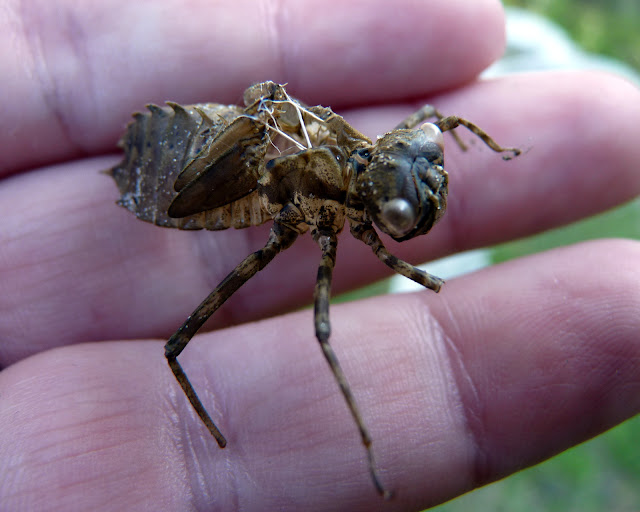Our first instinct, from past experience, was that it must be a cicada shell. But something didn't seem quite right; the legs were too long, the body not chubby enough.
A few internet searches later, we felt reasonably certain in stating this this was instead the exuvia, or final shed exoskeleton, of a dragonfly, although we can't be certain of the species. It's not uncommon for a dragonfly nymph to crawl some distance away from the water to undergo its final transformation. We detached it carefully to take a closer look.
Here's a closeup of the incredibly detailed head, with staring eye capsules front and center and the tiny antenna clearly delineated:
When we flipped the shell over, the mandible was obviously visible too:
The wings seem too small and the body section too large, until you remember that when the dragonfly emerges, it pumps fluid (haemolymph) from its body into its wings to expand and inflate them. (See great photography of this process here.)
The incredible detail left behind on the exuvia shows what an intricate creature the resulting dragonfly truly is. We've admired them as adults many times, and we love knowing that My Florida Backyard plays a role in their life cycle beyond just providing yummy mosquitoes for their dinners!






This was a great article! Thanks for sharing I never knew about their wings or that they emerged like a locust very interesting.
ReplyDeleteGreat post Jill. I didn't realize that dragonflies shed like that. I always enjoy seeing them flit about the gardens.
ReplyDeleteDo check out the roll roofing for paths. The cheaper roll is now around $34, was around $20 when I bought it last. The heavier duty, expensive roll is $76 at HD and $71 at a local roofing place, ABC Supply Co. if you have one in your area. I was tired of weed wacking paths and this was a great way to have a path. We had had some roll roofing that we had found to start, and I laid some found shingles too in other areas for paths. It all works great.
Have a wonderful weekend ~ FlowerLady
Flower Lady - That is a genius and inexpensive way to create garden paths. I think we can actually make good use of that at the butterfly garden where I work, where we're planning some major improvements this summer. Thanks for the idea!
DeleteWe have raised butterflies from the egg stage into adulthood, have never thought that dragonflies have a similar process. The pumping of the wings for drying and expanding is a beautiful sight.
ReplyDeleteThank you for sharing. I am amazed that it is so well preserved.
ReplyDeleteThis is quite possibly one of the coolest things I've ever seen!
ReplyDelete